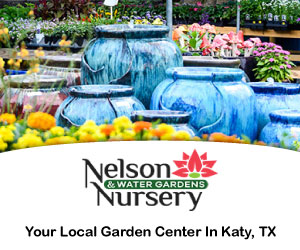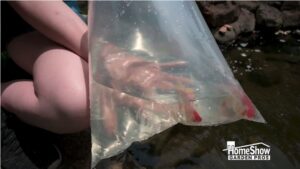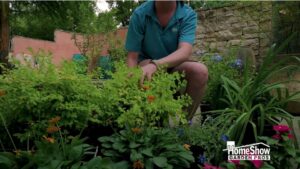Houston Organic Garden Tips & Advice
How To Top Dress Your Lawn With Compost
Transcript:
Sandy:
Hi, I’m Sandy.
Sherry:
And I’m Sherry with HomeShow Garden Pros.
Sandy:
And we are here today with Ian from Nature’s Way Resources. Ian, you have brought a display of turf and dirt and soil for us. What do we have going on here?
Ian :
So I wanted to show you how to top dress your lawn with compost. And on one side we have a porous sandy soil like we have up north close to the San Jacinto River. And on the other side, it’s what your soil should look like after a couple of years of application, what a healthy soil profile should look like.
Sherry:
So if you could pull your grass back and look, you’d probably see something like this.
Ian :
Yeah, very similar to that. Very sandy, well drained soil. Not a lot of organic matter.
Sherry:
Yeah.
Ian :
It’s just not the best for your grass to grow and not-
Sherry:
At my house I would see a combination of this maybe with some clay, because Houston has a very diverse soil.
Ian :
It’s very true. The further you go south, more clay we get. But it’s a very similar process to what we do to accomplish the same thing.
Sherry:
Right. So if we have something like that and we do the compost top dressing, which you’re going to show us, we should end up with something like this eventually.
Ian :
Correct, after a couple years of application.
Sandy:
Right, and this is, you can just feel, you can feel how nice this is.
Sherry:
It’s nice and silky-
Sandy:
Silky.
Sherry:
… and has moisture in it.
Sandy:
It has moisture and you can tell that it’s going to drain nicely.
Sherry:
And so the big difference is the organic material that’s in here.
Ian :
Correct.
Sherry:
Okay. And so show us how you do this.
Sandy:
Right. So how do we get from the sand to the beautiful organic?
Ian :
So like we were saying, we top dressed with compost. We always recommend to do a core aeration first. That’s where you pull out a plug of soil that helps reduce compaction and it gives you a spot for the compost to fall into. And that actually increases your organic matter deeper into the soil profile.
Sandy:
Great.
Ian :
It’s not a necessary step. It just helps expedite things to get things done quicker for better results.
Sherry:
So what would be the difference if somebody went into a store and got leaf mold compost compared to topsoil? Like component wise, how are they different?
Ian :
Well, our leaf mold compost, it’s a combination of leaves, grass, horse manure, and food waste, and that’s it. Soil is typically a combination of silt, sand, and clay.
Sherry:
Okay.
Ian :
So they’re very different products. So compost is actually a soil amendment. You would actually add it to the soil to help it make it healthier.
Sherry:
Yeah.
Ian :
It’s not an individual component of soil.
Sherry:
Okay.
Sandy:
Okay, so how am I going to top dress?
Ian :
So we always recommend top dressing about a quarter inch thick. Whenever I do my lawn, I use wheelbarrow and a shovel and I put some out and then I go back and rake it in with a garden rake.
Sandy:
Here.
Sherry:
Yeah, let’s, let’s do this.
Sandy:
Let’s get that on there.
Sherry:
Dump it on.
Sandy:
So tell me-
Ian :
It’s probably a little heavy for a quarter inch.
Sandy:
Okay.
Ian :
It’s not going to be detrimental as long as you can rake it in. And our hands are kind of simulating what you’d be doing with the rake, but…
Sherry:
So, we don’t want to cover the grass.
Ian :
Right, you want your grass to come through. You want everything to settle in between the blades so it doesn’t look…
Sandy:
Nice.
Ian :
So yeah, we want it to look nice. You don’t want to see the compost on top. I mean, you’re going to for maybe like a week or so, but once your grass grows up and you cut it, then you won’t be able to see it and you have all the organic matter.
Sherry:
And how often do you recommend compost top dressing?
Ian :
Once a year. You can do it twice if you wanted to, spring and fall.
Sherry:
Okay.
Ian :
It depends how much labor you’re willing to put in for your lawn.
Sandy:
Yeah.
Ian :
So it’s kind of a personal choice. But we do recommend at least once a year.
Sandy:
But it’s worth it in the end because your grass is going to be healthier and my soil, my water retention, how’s that going to help?
Ian :
Oh, it’s definitely going to help with your water retention. Compost is great at holding in water.
Sandy:
Great.
Ian :
And just adding nutrients back into the soil.
Sandy:
Wonderful. Well thank you very much for bringing this in and helping us learn between the soil and the compost and what we can do to improve our lawns. Thank you very much.
Ian :
Yeah, not a problem. I hope this helped.
Sandy:
Yes. And we answer more of these questions just like this on Saturday mornings with HomeShow Garden Pros.



